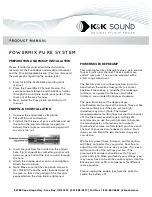
If the ELM is in alarm the Vigilant will not register the alarm, it will instead reset the ELM
sensor.
When the ELM sensor is reset, the Vigilant will poll the sensor again in 90 minutes to see if it
is still in alarm.
Assuming the electrolyte level is still low, the process of the Vigilant polling the ELM alarm
and resetting it will occur 3 times.
If the Vigilant polls and detects the ELM alarm 3 times, it will then register the alarm on the
system. The alarm will appear under the alerts page, on the monitor ELM LED, on Relay 1,
and on the associated Modbus points.
When the water level is topped off and the ELM is re-calibrated, the alarm will clear
immediately.
It's important to understand this process when troubleshooting. Due to the delays between
resets, it can take up to 7 hours and 45 minutes for the Vigilant to register the ELM alarm. This
means there could be an ELM sensor visibly in alarm on the battery, but the alarm is not
registered in the software.
When troubleshooting ELM alarms in the field, rely on the ELM
sensor LED rather than the Vigilant software.
If an alarm is cleared before the Vigilant has a
chance to poll it 3 times, that alarm will never register in the software.
3.0 Clearing ELM Level Alarms
This section will outline how to clear an ELM alarm when the level is confirmed to be low. There
are 2 ways to clear alarms, either at the ELM sensor in the field, or from the Vigilant web-interface.
Clearing from the web-interface is the preferred method if possible. Always be sure to top the
water level off before following the steps below.
3.1 Clear Alarms at the ELM
If the technician servicing the ELM does not have access to the web-interface, the sensors can be
calibrated individually at each sensor.
1. Identify the ELM sensor that is in alarm by the red low level LED.
2. Confirm the water level is at least a half inch above the minimum line. If not, refill it.
3. Remove the cover on the bottom of the sensor and unplug the power cable. The sensor LEDs
should turn off.
4. Plug the cable back into the sensor to power it on.
5. When the sensor is powered on, the green "No Fault" LED will blink for 10 seconds.
6. As soon as the blinking starts, press and hold the "RS" button until the LED stops blinking
(about 2-3 seconds).
7. The LED should now be solid green which means the sensor is calibrated.
8. Press the RS button to take a manual measurement and confirm the alarm is cleared.



























